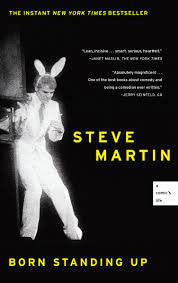Click on the above image or here to register. It’ll be on Teams.
If you just want to watch, no problem. If you just want others to watch, no problem.
I’ll go about 30-40 mins and then we’ll Q&A/discuss for a similar stretch of time, with attendees either submitting questions in the chat during my presentation or offering them live on mike afterwards.
We’ll record and share the recording. A PDF copy of the slide deck will also be shared.
Why May 1? It’s just been a while since I’ve done one and demand builds.
Throughline and I remain committed to the goal of socializing the need for grand strategic thinking regarding climate change and how our hemisphere will need to adapt to its decades-long unfolding, so please help us spread this message as you see fit by re-extending this invitation to your own networks.
You know, I recently watched the first half of Apple’s two-part documentary on Steve Martin and his career.
The first episode was incredibly revealing because it showed how Martin had slowly built and honed really just a single stage show over many years before it finally clicked.
For about 15 years, really from his teenage stint working at a Disneyland magic store and extending right through to his breakout performances on the opening seasons of Saturday Night Live, Martin worked that singular presentation layer by layer. At first, it was an incredibly tough sell because he was pushing a brand of comedy truly out of step with the politics of his age (late 60s/early 70s). As Elvis himself told him, his comedy was “oblique” to everything and everyone else out there.
For Martin then, it was really a matter of those bits and pieces coming together into this iconic whole that, once his audience caught up to what he was doing, eventually broke through to mass acceptance and really made him the first comic in history capable of filling arenas (my very first “concert” was his show in the Dane County Coliseum during his historic Wild and Crazy Guy tour).
There wasn’t this wide array of Steve Martin performances; there was just this singular presentation that grew and expanded over time and eventually connected with an incredibly wide audience.
As Martin explains, instead of the usual set-up that creates tension and then a punchline that releases that tension in a very explicit fashion (as in, audience: LAUGH HERE!), he sought to create tensions that were never directly deflated but kept simmering out there until the audience caught on that this lack of resolution was — in and of itself — the actual joke (basically, the hipster doofus doing comedy without realizing that he’s not all that funny).
In short, a really hard sell given the comedy norms of the time, in many ways because his act is a meta-commentary on traditional comedy delivery — a style that a generation of comics have since embraced (when they’re simultaneously telling the joke and explicitly commenting on their own material/delivery, like a magician who explains the trick while they’re doing it but somehow still pulls off the trick in a way that baffles you [Ricky Jay was the master of that]). Martin’s specific trick was that he forced the audience to make those connections on their own.
So why am I telling you this?
Watching the show confirmed a lot of things about my own career. I have crafted and honed and delivered basically the same set for decades now:
This is globalization
This is how came about
This is what’s going on with it now.
This is where it is inevitably heading due to forces X, Y, and Z
This is what that future will look and feel like
This is how we get ready for that future
And this is how we can shape that future.
I am … a broadly framing guy!
Delivering briefs is a lot of like delivering a stand-up set: you have your basic points to make, tensions to create and release, and so on. Most of all, you want to alter your audience’s frame of reference: take them somewhere they’ve never been but will be amazed by.
Tension and release.
Insert AWARENESS HERE!
I spent a solid decade building The Pentagon’s New Map brief and then another decade delivering it around the world.
I started building and honing this America’s New Map brief starting in 2011 — or thirteen years ago. I expect to be working and delivering it for at least another decade.
On some level, thinking in grand strategic terms, you NEVER want your audience to totally catch up with you because you want to keep pushing the time envelope so that you’re about 5-15 years ahead of the punchline hitting home.
And so you stay on the road, doing gigs both big and small, honing your message just a little bit after each and every performance.
I simultaneously love and hate my career: creating tension, keeping ahead of the audience, and, by doing so, never achieving genuine release — by design.
I honestly don’t know why I so compulsively keep at it. It’s just my purpose, I guess, and that self-realization is enough to motivate me.
Sign up to take the America’s New Map MOOC (Massive Open Online Course) at edX






